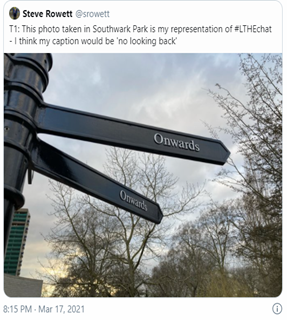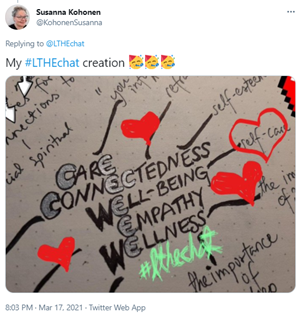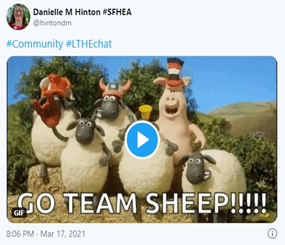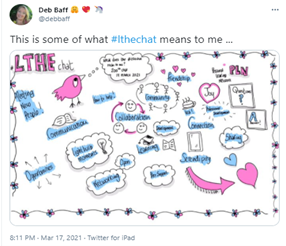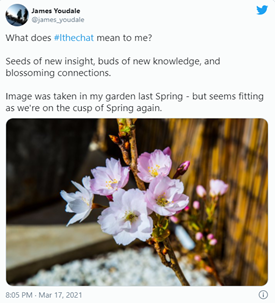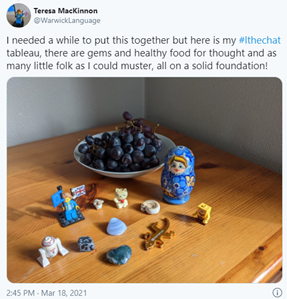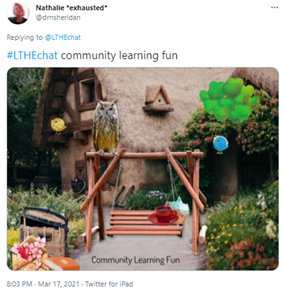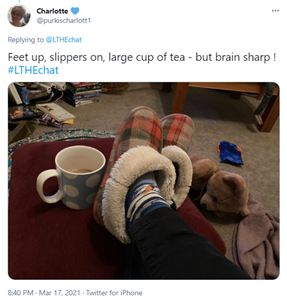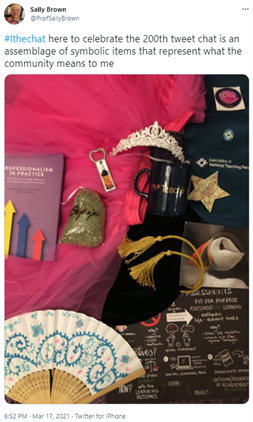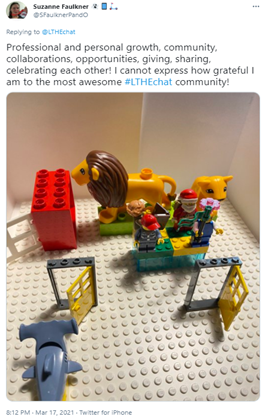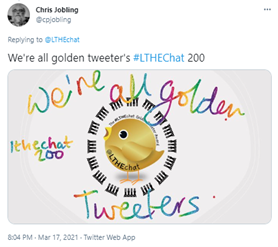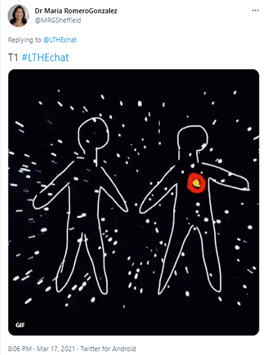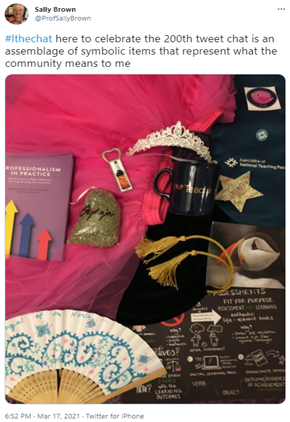Gems, buds and slippers, or what a series of visualisation tells us about the Learning and Teaching in Higher Education tweetchat (#LTHEchat)
Chrissi Nerantzi1
1Manchester Metropolitan University, Manchester, UK
Corresponding Author:
Chrissi Nerantzi, University Teaching Academy (UTA), Manchester Metropolitan University, All Saints Building, Oxford Road, Manchester, M15 6BG, UK.
Email: c.nerantzi@mmu.ac.uk
Abstract
This article is an inquiry into what the professional development initiative Learning and Teaching in Higher Education tweetchat (or #LTHEchat for short) means to some of its participants, as expressed through their visualisations provided during the 200th tweetchat on the 17th March 2021. The findings suggest that the #LTHEchat is experienced as a caring and inclusive community of diverse individuals who come together to connect, support each other, experiment, and develop themselves and their practice.
Keywords
higher education, professional development, social media,
diversity, inclusion, community
Introduction
The Learning and Teaching in Higher Education tweetchat (or #LTHEchat for short) started as a pilot in 2014. Tweetchats introduced during the open cross-institutional course Bring Your Own Devices for Learning, #BYOD4L (Nerantzi & Beckingham, 2014; Reed & Nerantzi, 2014) and their popularity gave me the idea that a tweetchat as a stand-alone openly licensed professional development initiative could be useful (Beckingham et al., 2015; Nerantzi, 2016). And that is how it all started. An experiment with three further colleagues. Together we became the #LTHEchat steering group. This initiative is still very much alive in 2021. The truth is that the #LTHEchat rapidly generated a tsunami of interest by participants from across the United Kingdom and further afield who came back week after week. Pasquini and Eaton (2019, online) note that “digital and social media platforms are changing the manner and timing through which higher education professionals participate in learning and development.” This is something that became apparent also with the #LTHEchat and through further open professional development initiatives that encourage self-directed participation and development (Nerantzi, 2017; Nerantzi & Gossman, 2018).
It seemed that there was an appetite for the #LTHEchat. More and more individuals started volunteering to be our guests and the annual programme filled up quickly. Our strategy was to be inclusive and represent diverse voices and perspectives from across the sector on topics that were of interest to these individuals and the wider community.
After a year, and only a few individuals working behind the scenes, it was clear that this way of working could not be sustained. I felt that rotating organising teams could help and be beneficial in more ways than one. They enabled the community to be directly involved in the organisation, planning and facilitation of the chat, created a sense of shared ownership and responsibility, and also kept the chat fresh and current. Today, and for some time now, the chat can run without its originators. Collaborating also with AdvanceHE and the Association for Learning Technology (ALT), for example, extended its reach and connected communities.
Method and data collection
This inquiry follows Rolfe et al.’s (2001) reflective model using the three key questions: What? So what? Now what? These questions provided a flexible structure to report, analyse, discuss and make sense of the lived experience as expressed through the visualisation.
General ethical principles of informed consent were applied sympathetically following guidelines by the British Education Research Association (2011). In particular, regarding data collection for this study, participants were notified in advance of this evaluative tweetchat, the purpose of it, and the use of tweets. Participants’ consent was requested in order to use what they shared during this chat including tweets, retweets and images as data. We were explicit in informing everyone that the data collected during this chat would be published as open data, to make it available and reusable for further research and teaching activities while we used it to gain insights into how the chat is experienced and inform the evaluation of the initiative. Collection of data via Twitter is not uncommon (Kara, 2015), and in this case the recommendations of Atenas, Havemann and Timmermann (2020) regarding the use of open data to inform academic development were followed.
Furthermore, special care has been taken around the contributors’ identities that were shared via Twitter together with their response. The contributors are named in this article with their permission (Kara, 2018; Eaton & Pasquini, 2020).
The data were gathered using a Padlet wall in which the thematic analysis took place (Braun & Clarke, 2006). The inductive approach applied to the analysis helped illuminate themes in the data gathered (Robson, 2011). In Padlet it was easy to move the data around manually, group data and identify themes and label these. The data were interrogated, and the visual and written parts were used for the analysis. The Padlet used for data analysis can be accessed at https://manmetuni.padlet.org/cnerantzi1/khptuo93jndx5qns.
The data gathered and the analysis reported within this article were shared with three contributors to get their perspectives on how the data gathered was synthesised (Nind, 2011) and to establish the truthfulness of these findings and conclusions based on these (Kara, 2015). These contributors agreed with the findings and their presentation. They did not question any aspect of the analysis, nor did they make any further suggestions or interpretations.
What?
Two hundred #LTHEchats later it was about time to evaluate this initiative, and this is what happened during chat number 200. Reflections on the overall data collected from this chat and what is under consideration for the future of the chat has already been reported back to participants (Nerantzi & Beckingham, 2021).
As a person who thinks through stories and pictures, I felt that it may be useful to see what the #LTHEchat means to individuals who participate though a visual response that can be shared during the chat. And this is what happened. An open invitation was shared in advance so that individuals could reflect and prepare something and then share at the beginning of the chat.
A series of questions were prepared in advance. These were shared progressively during the chat. Questions followed an introductory task that invited visual responses from participants. This was used for data collection:
Please consider preparing a picture of an object, model, drawing, collage etc. with a caption that shows what the #LTHEchat means to you. You will be able to share this during the chat. We can’t wait to see your creations!
It was hoped that the responses would illuminate some of the key motivations of #LTHEchat participants; something which, as noted by Eaton and Pasquini (2020), is perhaps under-researched in networks.
Mayer (2005) in his multimedia theory of learning notes that written and visual language combined can be powerful strategies for learning. Are such approaches also valuable in research? Kara (2015) notes that creative methods can be valuable research companions to more traditional approaches to gathering data, and also help sprinkle creativity into more established methods. In referring to model making, Gauntlett (2011) states that such a visual approach can also help individuals to make novel connections, thereby gaining new insights into a particular experience for example. The idea of model making is based on Papert’s (1980) constructionist learning theory through which hands-on learning through model making is enabled. Furthermore, creative methods can also be valuable in communicating research (Wilkinson & Weitkamp, 2016). Buckley and Nerantzi (2020, p. 198) note that “presenting data, concepts and outputs through a visualisation helps us communicate more effectively complex and often large amounts of information or concepts and identify patterns.” These visualisations can exist in 2D and 3D.
This article focuses on the responses to this visual task during the 200th #LTHEchat on the 17th March 2021. In total, 129 individuals visibly participated in this (Figure 1). Participants generated 966 tweets during this chat. Participants were informed in advance that their tweets would become open data to evaluate the #LTHEchat.
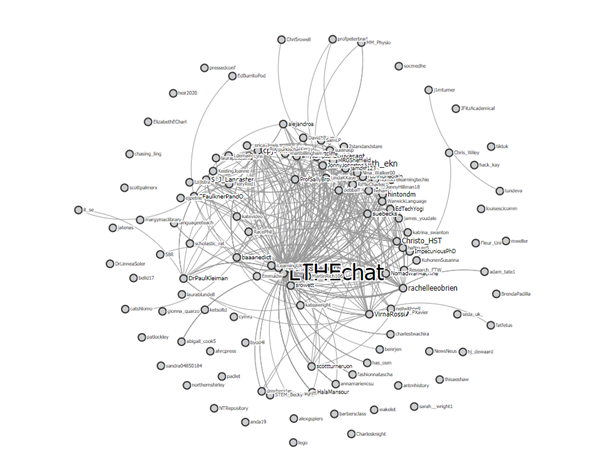
Figure 1. The 200th
#LTHEchat visualisation by Sarah Honeychurch using
Tagsexplorer created by Martin Hawksey
Thirty-four visualisations were shared by participants as a response to this task. These visualisations became data that was gathered to gain insights into what the #LTHEchat meant to these participants. Examples have been included in this article to illustrate the emerging themes.
So what?
Twenty-one (62%) responses to the task included a visualisation and a text response within the tweet text within the visualisations. Thirteen (28%) visualisations were without text.
Media
Firstly, responses were categorised by the media used to create these visualisations. Visualisations were accompanied by captions within each tweet. The visualisations shared had the following characteristics based on the media used to create these. The frequency is also noted.
· Photo (physical objects, nature, people): 14 (41%)
· Digital still creations (collage, stretch notes, drawing, wordle): 11 (32%)
· Gifs: 7 (21%)
· Drawing by hand: 2 (6%)
Example responses are shown in Figure 2 together with the themes that emerged through the analysis.
|
Growth |
Connection, Caring |
|
Connection, Community |
Connection, Growth, Caring |
Figure 2. Example responses and identified themes
It was noted that contributors, beyond the different media, used a range of metaphors including nature, toys and objects and scenes to express and share what the #LTHEchat meant to them (Figure 3). These metaphors were useful in analysing and synthesising the data gathered (Fletcher, 2013).
|
Connection, Growth |
Connection, Diversity, Inclusion, Growth |
|
Connection, Growth |
Flexibility, Connection, Growth |
Figure 3. Metaphors
Themes
The themes that initially emerged through the coding are the following:
· Connection
· Growth
· Caring
· Diversity
· Inclusion
· Flexibility
The analysis of the visualisations illuminated a further characteristic or theme, common across all contributions. This was playfulness as expressed through the visualisations themselves (Figure 4).
|
Connection, Diversity, Inclusion |
Connection, Inclusion |
|
Connection, Diversity, Inclusion |
Connection, Care |
Figure 4. Playfulness
Therefore, playfulness was considered in addition to the above themes.
Furthermore, the word "community" came up in 15 visualisations explicitly or within the tweet text, while many visualisations depicted “community” visually. Such examples are included in Figure 2, 3 and 4.
When looking at Siemens’ (2006, p. 112) perspective of community as “a connection-forming space”, the findings from this inquiry seem to be aligned with this, as “connection” strongly featured in the visualisations. “Community” seems to define what the #LTHEchat means to those contributors as an overarching characterisation of what the chat is. It needs to be noted that “community” is also used in the strapline of the chat “The weekly Learning and Teaching in HE chat created by the community for the community Wednesday 8-9pm”. Finding “community” present explicitly and implicitly in the visualisations, indicates that the chat is perceived as a community by these contributors.
The final set of identified themes of the #LTHEchat community therefore seem to be the following:
· Playfulness
· Connection
· Growth
· Caring
· Diversity
· Inclusion
· Flexibility
Now what?
The themes identified through the analysis of the visualisations provided as a response to the task provided valuable insights into how these participants experienced the #LTHEchat and what it meant to them.
Please consider preparing a picture of an object, model, drawing, collage etc. with a caption that shows what the #LTHEchat means to you. You will be able to share this during the chat. We can’t wait to see your creations!
Visual map
After the themes were identified, and while searching to understand the relationships among these themes, the following visual map was created. It is based on the concept of an outcome space, often used as the final output of a phenomenographic study to illustrate the logical relationships among categories of descriptions (Marton, 1981). However, similar visual analytic techniques and constructs are also common when using creative research methods (Kara, 2015).
The visual map developed using the findings from this study is a similar construct to such a phenomenographic outcome space. Within this map, the themes that emerged through the subsequent analysis have been used and arranged using an iterative process in such a way that they depict the logical relationships among these. As a result of this process the visual map shows the #LTHEchat as a community and its characteristic features based on the themes (Figure 5).
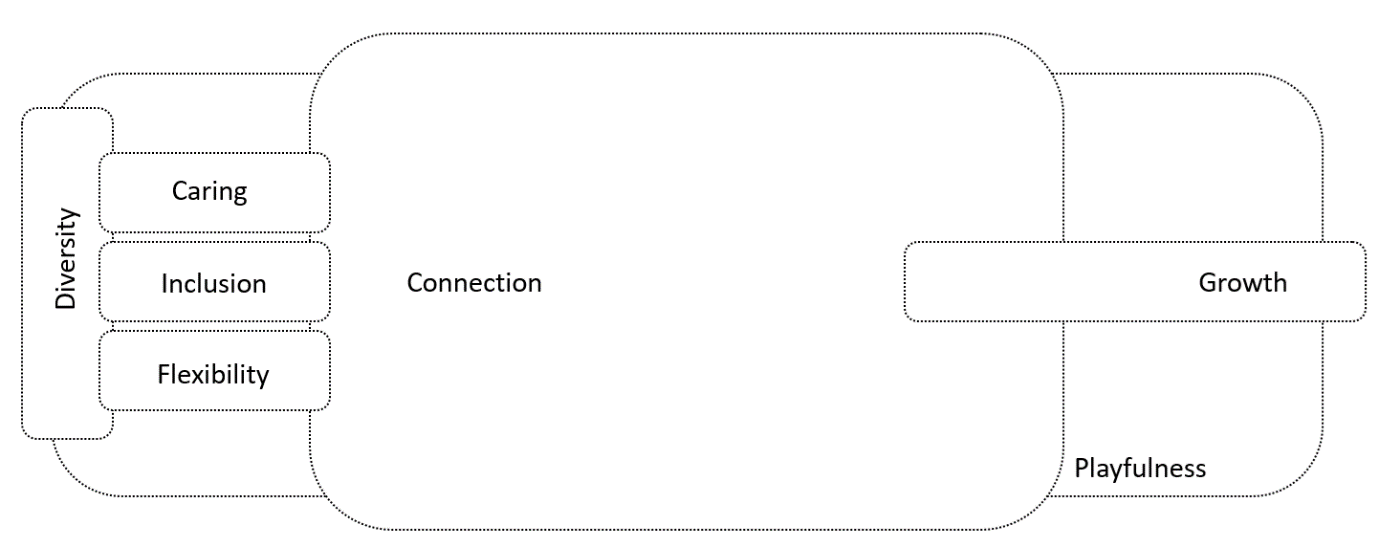
Figure 5. Visual map of the #LTHEchat as a community
The above visual map shows that the diversity of participants in the chat, their flexible attitude, caring nature and inclusive approach, enable connections to be made. Individuals often seem to be daring to try new approaches and demonstrate playful characteristics. Therefore playfulness ‘hugs’ the whole experience itself and seems to lead to growth, individual and collective. Individuals and the connections they make to diverse others and their ideas seem to be at the heart of the #LTHEchat and it is exactly that that gives this initiative the characteristics of a lived community for those contributors.
This is also expressed in the following vignette (Figure 6) that was provided in addition to the visualisation shown on the left hand-side by the same individual sharing further related details.
|
Connection, Diversity, Inclusion |
“Several items refer to specific people e.g. Individual 1: TuTU, Individual 2: Fridge magnet, Individual 3: Star map of Newcastle, Individual 4: who urges me to chill out more often like a puffin and a fan she hand painted for me. My book represents the scholarship support I get from others in the community. NTF stole represents the number of NTFs who take part. ILT mug represents my past work there, herbs are international contexts especially Individual 5 and sketch note graphic represents my work this year with Individual 4 on post-pandemic assessment which I have widely circulated through the tweetchat community.” |
Figure 6. Vignette with complementary information linked to the visualisation
Judson’s (2019, online) words “we live and thrive in communities. We imagine ideas, stories and images that unite us and help us evolve within communities” seem relevant in the context of the #LTHEchat. Perhaps the collaborative and participatory nature of the #LTHEchat, its distributed and social leadership model, the introduction of the rotating organising teams and mentoring arrangement boosted participation and commitment and created a shared sense of ownership and community while also generating opportunities for collaboration (Brown, 2001; Gilpin, 2020). It also needs to be acknowledged that the strapline of the #LTHEchat is “created by the community for the community”. While the originators of the #LTHEchat were hoping that the initiative would become a community, seeing it characterised as such by these contributors seems to indicate that it is a lived community.
Research has shown that diversity is a key factor of success in cross-boundary open communities as an earlier phenomenographic study in the context of open cross-institutional academic development has shown (Nerantzi, 2017). In this study, community was experienced in three ways:
1. participants felt they were members of the course community;
2. participants were part of a community external to the course; and
3. participants felt that the course was part of a community that stretched beyond the boundaries of the course.
Based on these findings, Nerantzi and Gossman (2018) considered a cross-boundary community-based model for academic development, also based on Siemens’ (2006) notion of community and (2006) and Popovic and Plank (2016). More recently, during the pandemic, Eringfeld (2021, p. 154)—in her research studying the experiences of students and academics during the pandemic within the Faculty of Education at the University of Cambridge in which she collected data via an open access audio journal—indicates a post-coronial university as a space “for practical learning, creativity and alternative epistemologies. […] increased engagement with community-based and experience-based learning, physical activities and more practical forms of learning that involve the ‘real world’ outside academia.” Alternative modes of professional development, more outwards-facing, connected, porous and communal in nature have been at the heart of the #LTHEchat from its inception.
The #LTHEchat seems to have the characteristics of a cross-boundary professional development community as it has attracted not exclusively higher education professionals, but also students and individuals from other education sectors and the wider public. What needs to be noted is the affective nature of the #LTHEchat community as highlighted in the findings under the “caring” theme. The human relationships created within this community seem to create a social glue that has brought diverse #LTHEchat participants closer together within this open space, to learn with and from each other, dare new approaches and be creative (Nerantzi, et al., in print).
This inquiry into what the #LTHEchat, an informal professional development initiative, means to those participants using visualisations was valuable in finding out that the chat is experienced as a caring and inclusive community of diverse individuals who come together to connect, support each other, experiment and develop themselves and their practice. These insights will be valuable in informing plans for the future of the #LTHEchat and identifying strategies to sustain this initiative further if there is an appetite for it. Something that would be useful to explore is if (and to what extent) professional communities such as the #LTHEchat may also contribute to the wellbeing of those participating, something that is becoming increasingly more important for individuals and institutions.
Acknowledgements
I would like to thank Sue Beckingham, Peter Reed and Dr David Walker for starting the #LTHEchat together, all organising teams, mentors, collaborators, guests and participants for their sustained engagement and their support. A big thank you also goes to Dr Javiera Atenas and Dr Laura Pasquini for their help in organising the 200th #LTHEchat and their valuable advice and everybody who provided a visual response to the task and shared their insights for which I am grateful.
References
Atenas, J., Havemann, L. and Timmermann, C. (2020) Critical literacies for a datafied society: academic development and curriculum design in higher education. Research in Learning Technology, 28. https://doi.org/10.25304/rlt.v28.2468
Beckingham, S., Nerantzi, C., Reed, P. and Walker, D. (2015) Speedy professional conversations around learning and teaching in higher education via the brand new tweetchat #LTHEchat. Journal ALISS Quarterly, February 2015. http://alissnet.org.uk/aliss-quarterly/
British Education Research Association (2011) Ethical guidelines for educational research. BERA. https://www.bera.ac.uk/publication/ethical-guidelines-for-educational-research-2011
Brown, R. E. (2001) The process of community building in distance learning. Journal of Asynchronous Learning Networks, 5(2). https://olj.onlinelearningconsortium.org/index.php/olj/article/view/1876
Braun, V. and Clarke, V. (2006) Using thematic analysis in psychology. Qualitative Research in Psychology, 3(2), 77-101. https://doi.org/10.1191/1478088706qp063oa
Buckley, C, A. and Nerantzi, C. (2020) Effective Use of Visual Representation in Research and Teaching within Higher Education. International Journal of Management and Applied Research, 7(3), 196-214. http://ijmar.org/v7n3/20-014.html
Eaton, P. W. and Pasquini, L. A. (2020) Networked practices in higher education: A netnography of the #AcAdv chat community. The Internet and Higher Education, 45(100723). Advance online publication. https://doi.org/10.1016/j.iheduc.2019.100723
Eringfeld, S. (2021) Higher education and its post-coronial future: utopian hopes and dystopian fears at Cambridge University during Covid-19. Studies in Higher Education, 46(1), 146-157. https://doi.org/10.1080/03075079.2020.1859681
Fletcher, G. (2013) Of baby ducklings and clay pots: method and metaphor in HIV prevention. Qualitative Health Research, 23(11), 1551-62. https://doi.org/10.1177/1049732313508012
Gauntlett, D. (2011) Making is connecting. The social meaning of creativity, from DIY and knitting to YouTube and Web2.0. Polity Press.
Judson, G. (2019) Higher Education in the digital age: Imagination matters. imaginED, 4 September 2019. http://www.educationthatinspires.ca/2019/09/04/higher-education-in-a-digital-age-imagination-matters/
Kara, H. (2018) Research Ethics in the Real World: Euro-Western and Indigenous Perspectives. Policy Press.
Kara, H. (2015) Creative Research Methods in the Social Sciences. A Practical Guide. Policy Press.
Marton, F. (1981) Phenomenography – describing conceptions of the world around us. Instructional Science, 10 (2), 177-200. https://doi.org/10.1007/BF00132516
Mayer, R. (2005) The Cambridge Handbook of Multimedia Learning. Cambridge University Press.
Nerantzi, C. (2017) Towards a Framework for Cross-Boundary Collaborative Open Learning in cross-institutional academic development. PhD thesis, Edinburgh: Edinburgh Napier University. https://www.napier.ac.uk/research-and-innovation/research-search/outputs/towards-a-framework-for-cross-boundary-collaborative-open-learning-for-cross-institutional-1
Nerantzi, C. (2016) Chapter 7: Designing-in social learning: A potpourri from open professional development practices and how Aristotle, Socrates and Plato can help. In: W. Kilgore (Ed.) Humanizing online instruction. Pressbook. https://humanmooc.pressbooks.com/?
Nerantzi, C. and Beckingham (2021) #LTHEchat 200: Closing the feedback loop. LTHEchat blog, 15 April 2021. https://lthechat.com/2021/04/15/lthechat-200-closing-the-feedback-loop/
Nerantzi, C. and Beckingham, S. (2014) BYOD4L – Our Magical Open Box to Enhance Individuals’ Learning Ecologies. In: N. Jackson & J. Willis (Eds.) Lifewide Learning and Education in Universities and Colleges E-Book. http://www.learninglives.co.uk/e-book.html
Nerantzi, C., Chatzidamianos, G., Stathopoulou, H. and Karaouza, E. (2021) Human Relationships in Higher Education: The Power of Collaboration, Creativity and Openness. Journal of Interactive Media in Education, 1. http://doi.org/10.5334/jime.668
Nerantzi, C. and Gossman, P. (2018) Cross-boundary communities, an alternative vision for academic development. Compass Journal, 11(2). http://dx.doi.org/10.21100/compass.v11i2.800
Nind, M. (2011) Participatory data analysis: a step too far? Qualitative Research, 11(4), pp. 349-63. https://doi.org/10.1177/1468794111404310
Papert, S. (1980) Mindstorms. Children Computers, and Powerful Ideas. Basic Books.
Reed, P and Nerantzi, C (2014) Tweet-chats: the new ‘condensed’ synchronous discussion forum? In: Nerantzi, C. and Beckingham S. (eds.) Using social media in the social age of learning, Lifewide Magazine, Special Edition, June 2014, pp. 13-16.
Pasquini, L. A. and Eaton, P. W. (2019) The #acadv Community: Networked practices, professional development, and on-going knowledge sharing in advising. NACADA Journal, 39(1), 101-115. https://nacadajournal.org/doi/abs/10.12930/NACADA-18-031
Popovic, C. and Plank, K. (2016) Managing and leading change. Models and practices. In: D. Baume & S. Popovic (Eds.) Advancing Practice in Academic Development (pp.207-224). Routledge.
Robson, C. (2011) Real World Research (3rd edition). John Wiley & Sons.
Rolfe, G., Freshwater, D., and Jasper, M. (2001) Critical Reflection for Nurses and the Caring Professions: A Users Guide. Palgrave.
Siemens, G. (2006) Knowing knowledge. https://ia801300.us.archive.org/7/items/KnowingKnowledge/KnowingKnowledge.pdf
Wilkingson, C. and Weitkamp, E. (2016) Creative Research Communication: Theory and Practice. Manchester University Press.
